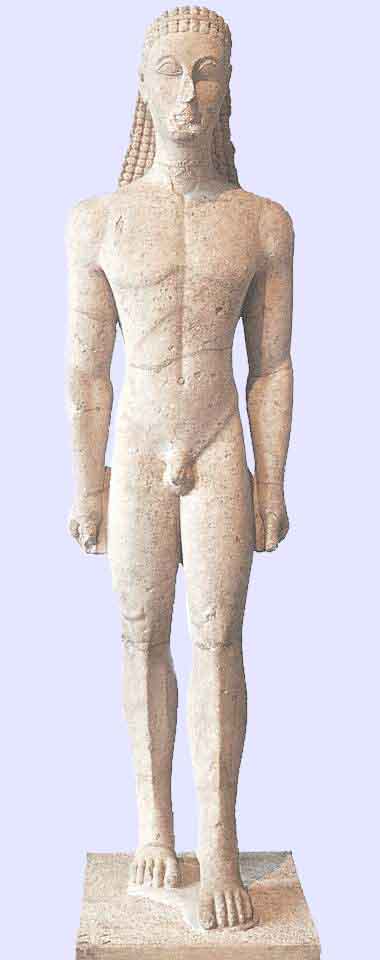
|
|
Geometric Period 900-700 BC meander - Greek key pattern prothesis - scene of figure laying out dead abstract human figure used as a grave marker "Krater" |

|
|
Kore (Goddess) "Lady of Auxerre" 650 BC Orientalizing Period
flat head, shovel face, traingular form of hair
connection to Ancient Near East: Conical skirt, rounded shoulers
connection to Ancient Egypt: rigid posture, block like form, stone carving, & the figural conventions |

|
|
Kouros 600 BC Archaic Period
1. not on block form unless truly neccesary (hands) human form is supreme, more natural 2. male figures are nude and females draped 3. facial features sit on form 4. muscles are shown as incised lines |

|
|
Kroisos 530 BC Archaic Period
functions as shrines or grave marker shows greater details of human anatomy pigment on statue seems more life-like - rubbed w/ beeswax
*only 70yrs later from Kouros rapid stylistic changes in Greek Art human form more naturalistic
*Archaic grin/smile - represents lived life |

|
|
Peplos Kore 530 BC Archaic Period
peplos - garment that cinches at the waist female draped body 3-D can walk around whole structure |

|
|
Temple of Hera I 550 BC @ Paestum
peripteral temple - sorrounded by columns more interest in viewing the outside of temple structure inside was considered official house for Gods outside was for worshiping & sacrifice at the altar |

|
|
stylobate - top step, columns rest on it shaft - cylindrical with fluting entasis - wider bottom capital - top of column echinus - simple drum abacus - square shape support entablature - horizontal structure architrave - bottom of entablature metopes - plain or carved reliefs triglyps - 3 vertical bands pediment - gabled roof |

|
|
Temple of Artemis 600-580 BC Pediment: Gorgon Medusa
standing figure at the center, highest point gorgon - monster placed on temple to deflect evil
|

|
|
Achilles and Ajax 540 BC vase painting by Exekias (first known painter)
amphora - storage jar black figure - painted on black vase figures playing a game of dice composition of figures follow the shape of the vase (spears, body, armor on the sides)
|

|
|
Herakles Wrestling Antaios 510 BC painter: Euphronios
red-figure - painting on red vase Hercules' composure is ideal (calm and strong) |